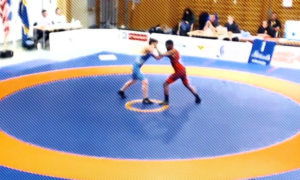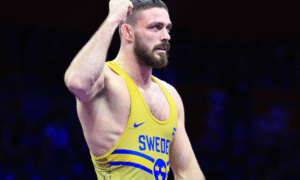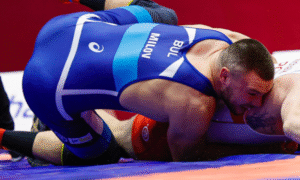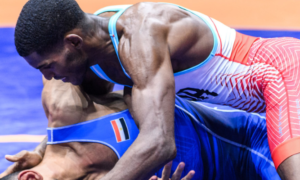With two more competitive endeavors available before 2025 arrives, Lithuania’s Mantas Knystautas (130 kg) is maintaining quite the active profile.
Knystautas, who earned World bronze in ’22, has signed up for the last two European tournaments of the year: the Haparanda Cup (Sweden) and the Haavisto Cup (Finland), respectively. Knystautas’ entries into both events comes on the heels of what, for him, was a busy but challenging campaign in ’24.
Knystautas 2024 Overview
It began last January when Knystautas placed 3rd at the Grand Prix Zagreb Open in Croatia. In that event, the 6’7 heavyweight defeated countryman Roman Fridrikas, Sukhan Buidze (SUI), and German Franz Richter before falling to Fardin Hedayati (IRI) in the semifinal. Knystautas then received a forfeit from Laszlo Darabos (HUN) in the bronze match. An opening round loss to ’18 World champ/two-time Olympic bronze Sergey Semenov (RUS) at the European Championships came next — but Knystautas bounced right back two weeks later to win his second-straight Thor Masters gold.
However, and despite having demonstrated consistent results throughout the season, Knystautas was not selected to compete in the European Olympic Qualifier. That distinction instead went to Fridrikas, who was edged in the quarterfinal by Jello Krahmer (GER) and therefore did not qualify 130 kg for Lithuania at the Paris Games.
Knystautas’ number was indeed called for the World OG Qualifier in May, which represented the last chance for all national federations to earn Olympic berths. The pressure was on, and Knystautas started off strong by coming up with wins over Moises Perez Hellburg (VEN) and ’21 U23 World runner-up David Ovasapyan (ARM), though a criteria loss to ’16 Olympic bronze Sabah Shariati (AZE) meant a trip to the repechage. Knystautas easily disposed of Nikolaos Ntounias (GRE) to advance to the bronze round; but because the World Qualifier also included a “true 3rd” match in each weight category, two more wins were necessary for LTU to qualify; and after Knystautas downed Ntounias, he was clipped by Pavel Hlinchuk (BLR) 6-5.
Dejection turned to celebration just weeks later when the International Olympic Committee, in conjunction with United World Wrestling, reallocated 16 Paris Olympic berths earned by Russian and Belarusian wrestlers (all of whom bearing AIN distinctions, or “Individual Neutral Athlete”). In short, these spots were re-assigned to a variety of national federations according to the order of placings at qualifying events; plus, both BLR and RUS decided to “soft boycott” the proceedings in the light of the IOC’s findings; and at the end of it all, Lithuania was awarded Hlinchuk’s berth at 130, which in turn meant that Knystatas would appear in his second straight Olympiad.
From Paris to Finland
Knystautas blitzed an overmatched Oussama Assad (MAR) in the qualification round of the Paris Olympics but lost a 1-1 passive decision to Lingzhe Meng of China in his subsequent bout. Meng, who has steadily improved over the past five years, was defeated in similar fashion by eventual runner-up Yasmani Acosta Fernandez (CHI), thus signaling an end to Knystautas’ second Olympic run.
It is not uncommon for wrestlers coming off of World or Olympic starts to go on brief hiatuses upon the dawn of each new competitive season. And it especially would have come as no surprise if Knystautas, who turned 30 in May, had decided to take a break considering the amount of activity in which he engaged in the months leading up to the Paris Games. He had performed in five events, medaled in two of them, and along the way endured the pressure of attempting to qualify his weight class, only to have dealt with the disappointment of falling just short before the news came down that he would, in fact, suit up for the Olympics after all. It was enough to warrant a respite for any high-level athlete, nevermind a top heavyweight who has eclipsed 30 years of age.
Instead, Knystautas hardly allowed for any downtime. In late September — a mere seven weeks following the Olympics — he entered the Valamar Cup in Croatia. The 130 kg bracket at Valamar was broken up into a round-robin, which delivered to Knystautas four matches. He won three of them to end up with silver with his lone loss coming at the hands of Ukrainian Vladyslav Kovalenko.
And now he has two more tournaments on the horizon to close out the year.
The level of competition at both the Haparanda and Haavisto cups can be a mixed bag depending on the year. In some cases, the degree of difficulty is quite high and brackets include a healthy number of accomplished entrants. There are also iterations of Haparanda and Haavisto which — for competitors, coaches, and fans alike — can be underwhelming. Whether due to scheduling conflicts relative to other events unfolding around the same time-frame or simply because many national federations prefer to use the last month of the year to rest and re-charge in order to prepare for continental championships in the spring, Haparanda and Haavisto tend to be inconsistent when it comes to participation. For example, at press time the 130 kg bracket in Haparanda presents six registrants (including Knystautas and Fridrikas) and four of those six are likewise registered for Haavisto — which currently displays only five names at 130.
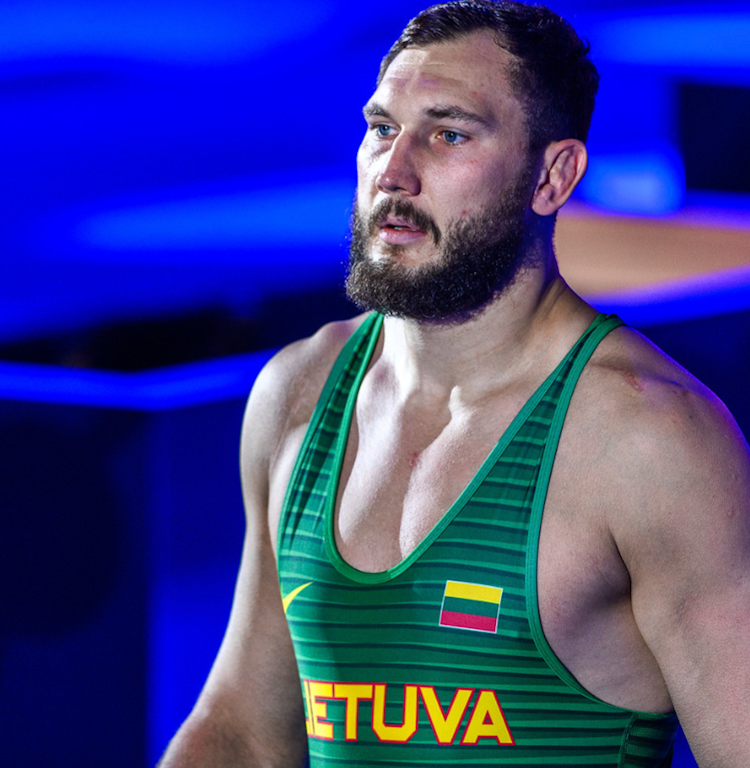
But that is not the point, is it? A wrestler like Knystautas, who is one of the best in the world in his weight division, is entering Haparanda or Haavisto for only one primary reason, which is to increase match time in an effort to stay sharp. 130 kilograms is a snug and tight environment, anyway, and the margin for error is exceedingly slim. The lines of demarcation separating World medalists from journeyman contenders is practically indiscernible to the casual eye. Those who are willing to sustain their focus and make adequate adjustments can find suitable value in any type of competitive environment, but the only way for that approach to prove effective is by routinely showing up to do the work.
In that light, it does not matter if the brackets at Haparanda, Haavisto, or both, carry consistent quality. What matters is the consistency of the very athletes who populate said brackets. Thus far in his career, Knystautas has demonstrated this attribute perhaps as well, if not on an even more pronounced basis, than the vast majority of European heavyweights. As such, his presence in these last two Nordic events of ’24 is about ending the year in a positive manner whilst remaining passionately dedicated to his short and long-term goals. In a weight class where outcomes are often decided by the faintest of margins, Knystautas knows that one lesson learned in one moment from one match in one tournament, or from one camp, can aid his cause in becoming a World or Olympic Champion in the future. So while it might have been initially surprising to spot an established name like his in the brackets of these two year-end tournaments, it is equally unsurprising when taking into account the value Knystautas sees in every opportunity, and how each opportunity might lead him to achieving his overall objective.
And it all starts with showing up to do the work.

Listen to “5PM57: Kamal Bey and David Stepanyan” on Spreaker.
Listen to “5PM56: Rich Carlson and Spencer Woods” on Spreaker.
SUBSCRIBE TO THE FIVE POINT MOVE PODCAST
iTunes | Stitcher | Spreaker | Google Play Music






